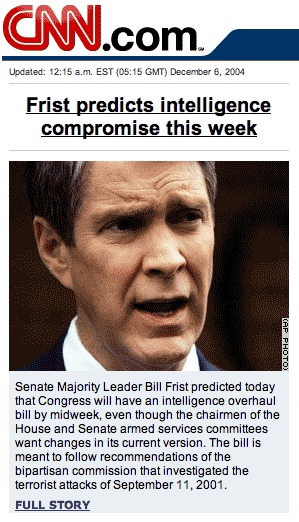iPhone Prediction Confirmed
 Way back on July 25th, I told you Apple was coming out with a cell phone. This was before any preliminary Motorola announcements, before any recent rumor mill gossip, and a full four months before Russell Beattie’s and Ross Mayfield’s great articles on the subject. I even told you the exact month: January of 2005.
Way back on July 25th, I told you Apple was coming out with a cell phone. This was before any preliminary Motorola announcements, before any recent rumor mill gossip, and a full four months before Russell Beattie’s and Ross Mayfield’s great articles on the subject. I even told you the exact month: January of 2005.
Lo and behold, via today’s announcement in Forbes magazine (which was via this article at Engadget), Apple has confirmed that not only will they be releasing a full-fledged Apple-inspired phone with Motorola circuitry, but it will likely be shown off in January to an eagerly-awaiting public at MacWorld Expo.
I, personally, can’t wait.
While I am very excited about the official announcement, the revelation that it will be a “mid-range” device probably means that I won’t dump my Treo for it. Once you’ve tasted the sweetness that is the high-range, full-featured phone, it’s tough to imagine going back. However, we all know that Apple is not in the business of producing anything “mid-range”, so I’d bet a large sum of money that this initial iPhone release is just the tip of the iceberg. Might we see a “PowerPhone” shortly thereafter? We most certainly will. The only question is when. Want another prediction? Same time next year.
So what is the moral of today’s iPhone announcement?
- I am all-knowing, all-powerful, and ever-sure… at least when it comes to technology predictions. :)
- Where there’s a cool product to be made, rest assured Apple will make it.
Now if only Steve Jobs could get over his hatred for television, maybe we’d see a damned Media Center Mac already. I know I’d pay a healthy sum of money for one.
Note: The photo illustration above is obviously not representative of what the Apple phone will look like. It’s the product of two-minutes worth of Photoshop work.
Referrer Spam is the New Amway
 Ever since I found out about Amway and other network marketing schemes many years ago, I’ve always considered them the lowest form of commerce in the world. I mean, you’re not creating a damned thing and you’re using your friends and personal contacts to move generally unneeded goods around the economy. All to make a profit for yourself.
Ever since I found out about Amway and other network marketing schemes many years ago, I’ve always considered them the lowest form of commerce in the world. I mean, you’re not creating a damned thing and you’re using your friends and personal contacts to move generally unneeded goods around the economy. All to make a profit for yourself.
I think we have a new winner now in the “lowest form of commerce” category though: referrer spam. I simply don’t understand the point of this silly practice. If you don’t know what referrer spam is, here is the “technology” in a nutshell:
Websites maintain automatic lists of other web sites which link to them. This is useful, for instance, if I write an article and I want to see who is linking to my article and what people might be saying about it. So every day or so, I check my “referrer log” for new links. Well, what referrer spammers are now doing is polluting my log file with obviously fake referrers like “vicodin-for-free.info” and “sex-with-jenna-jamison.org”. So as a result, I have to wade through hundreds of these links in order to get to real referring links.
What I don’t understand is what the point of it is. The referrer log is only accessible by me and surely nobody technical enough to be checking their own referrer logs would actually click on one of those links. I’ve heard another reason spammers do this is because some people display their “most recent referrers” live on their sites. If you’re doing this, STOP. It provides no value and only perpetuates the myth that referrer spam has a chance achieving its intended effect.
As an aside, the best way I’ve found to get around the referrer spam problem is to use Refer 2.0 to check your referrers. Refer 2.0 can sort referrers by frequency and most referrer spam has a frequency of one, so you can easily ignore any referrers who haven’t provided you at least two referrals.
Also, for a more complete statistical tracking package, make sure and check out Shaun Inman’s ShortStat. Shaun’s working on a spicy new beta right now which is quite nice, but in the meantime, feel free to use the current version. You can have a look at what the output looks like here.
sIFR 2.0: Release Candidate 2 is Finally Here
UPDATE: Version 2.0 is now available. See article here.
Alright, sIFR Release Candidate 2 is finally here. It’s been exactly two months since Release Candidate 1 and we’re happy to say that things have held up very well so far. Release Candidate 2 fixes a handful of minor issues, and barring any regression behavior which may turn up in RC2 (but probably won’t), we think we have a solid 2.0 release on our hands. Thankfully, we’ve taken care of this before the end of 2004, because according to the 2005 Web Design Forecast, sIFR will be a huge part of the emerging typographical landscape in the coming year.
We couldn’t agree more.
Before I get into the details of RC2, I just want to thank Mark Wubben for a) all the great javascript work he’s done on sIFR, and b) all the helpful support he’s provided to people asking for assistance in the comments. There have been over 700 comments on all sIFR threads so far, and Mark has managed to successfully attend to almost all of them which pertain to javascript or implementation. So once again, thanks Mark for being so helpful, and also for being a genius.
I also want to thank Danilo Celic and Stephanie Sullivan of Community MX for their help in bringing sIFR to the masses. Check out Danilo’s Breeze Presentation for a great overview of sIFR and also a peek at the power of Macromedia Breeze. I love Breeze more every time I see it.
And finally, two more thank yous. One to Zen Master Dave Shea for his helpful, even-handed, positive review of sIFR, and one to Sean Schroeder for his beautiful sIFR work on Prosper Magazine.
Oh yeah, and I almost forgot, Wes Carr and the folks at 2Entwine have taken sIFR and expanded it into Fotobuzz.org, a photo annotation engine. Instead of replacing text with sIFR, Fotobuzz replaces images for the purpose of annotating them inside Flash. It is really really slick. Make sure and check it out.
Now… on to the details.
First of all, to upgrade to sIFR 2.0 RC2, you need only re-export your .swf files and pop in the new sifr.js file. No implementation details have changed. So in other words, upgrading should only take a minute.
Here’s what we’ve improved/changed/fixed:
- sIFR now works in all reasonable versions of Opera. This should include all flavors of 7.x on both platforms.
- URLs of unlimited length are now supported. Flash unfortunately has a 128-character URL limit on textfields, but we’ve gotten around that with some crafty coding.
- Newline support is now added. If you place
<br />'sin your replaced elements, they will now be honored. - HTTPS is now supported for domain-protected files.
- sIFR now uses exact domain matching for domain-protected files. As a result, two-part domains like .co.uk are now eligible for protection.
- Various speed improvements.
- Minor selector bugs have been squashed.
- Browser detection is now exposed in the javascript so you can easily disable sIFR for any browser you’d like.
At this point, we believe all outstanding issues are now resolved. Please feel free to download the new release and let us know what you think! The instructions are now contained in a readme.txt file within the zip archive below.
Headline Writing 101
Lesson #1: Don’t scare the hell out of your audience with a poor choice of words.
The Big Three Oh
 Tonight, I am 29, and tomorrow morning, December 1st, I will turn 30. Hot damn! That decade just flew by! The whole decade thing is not that big of a deal to me because I feel like we count things by tens only for neurological convenience… not to mention that no other animal gives a damn about the number ten.
Tonight, I am 29, and tomorrow morning, December 1st, I will turn 30. Hot damn! That decade just flew by! The whole decade thing is not that big of a deal to me because I feel like we count things by tens only for neurological convenience… not to mention that no other animal gives a damn about the number ten.
But still…
When you reach a decade mark in your life, you can’t help but reflect on previous decades and measure expectations for the coming one. Rather than write a sappy, rambling essay about life and what my place in it is, I just wanted to sum up my three decades so far with one (run-on) sentence each and then spell out some goals on the record with the hopes that I might actually follow through on them:
Age 0-9: I was a standout wiseass in school, got in trouble quite a bit, and eventually learned to treat formalized education like a beneficial experience.
Age 10-19: My family moved from Pacific Palisades, CA to Seattle, WA, I grew to love the Northwest, and I drank my way through high school and into the University of Washington School of Business.
Age 20-29: My career focus landed decisively in advertising, design, and the creative arts, at one point I was one signature away from a nice early retirement, and now I have a great job that I love.
And that’s that.
I don’t really have any spectacular promises to make for the next ten years, but I have a few things I want to do:
- Buy a house in the South of France. Nice would be nice. A buddy and I decided in college that we’d go in on a summer home there. My target age was 34. Time to make good.
- Get married. (Note to self: requires girlfriend)
- Start thinking in seven figures. We’re on the verge of another, slightly more sane, tech boom, and I plan on doing a good amount of the booming.
- Make various unspecified health improvements. I treat my body like a temple, but only the sort of temple you’re allowed to throw concerts in occasionally.
- Drink a lot more water. That’s an easy one. Anyone know if this is really worth it? I’ve always thought the whole “8 tall glasses of water per day” campaign was a bit of a scam.
- Dive the top ten dives in the world. I’ve already done one in Kona, Hawaii and it was the most surreal thing I’ve ever seen — television, movies, and all other things included. I’ll take nine more of those please.
And finally, I hope that the next time one of these decade marks passes, my country will be a bit more popular around the world again. Or else, I’ll be writing you from Cascadia. :)
ESPN Wants Your Thoughts
One of my co-worker homies at ESPN headquarters, Kareem Mayan, runs his own blog over at Reemer.com and he would like your suggestions regarding subscription content on ESPN.com. Kareem was one of the driving forces behind ESPN Fantasy Football League Manager, and his excellent work is one of the main reasons the product is doing so well this year. Also, can I just mention really quick how much butt I’m kicking in the blogger league?
Anyway, if you’re an ESPN.com user and you have some suggestions for us, head on over to Reemer’s place and post your thoughts. With Kareem working on ESPN Insider now, expect a lot of great stuff coming down the pipe in short order.
Blog of the Moment: AdFreak

There’s a new blog on the block, and if you’re interested in the advertising industry, it’s worth adding to your blogroll. AdFreak, a product of AdWeek Magazine, is a collaborative effort by AdWeek staffers to chronicle all the latest and greatest campaigns in the ad world. Unlike the straightforward style of AdWeek Magazine, AdFreak presents its contents in a comical, sarcastic manner mildly reminiscent of the great Defamer.
Since I only have one TV and one Mac, I can’t be expected to keep up on all the latest ad campaigns myself, and that is where AdFreak excels. Check out this piece on Virgin Atlantic’s new online campaign. Brilliant stuff. I already wanted to fly on Virgin, but now I REALLY want to. Try out the dream interpreter… it actually works pretty well for most of the basic dreams (viz. “I came to work naked”, “I was falling off a cliff”, etc).
Online ad campaigns like the Virgin Atlantic dream interpreter and the new CNN Under your Command video piece are a good indication that the dawn of internet advertising is finally upon us. We’ve always known that garish, cheaply produced banner ads never did a whole lot for branding or sales, but now that we have things like Flash video and smart interactivity in our arsenal, the internet may soon overtake TV as the most immersive and effective advertising medium.
Before I worked at Disney/ESPN, I worked for a pretty major ad agency here in Seattle, and the attitude towards internet advertising back then was that it was sort of a “necessary evil” in the business. Everyone knew that being a full-service agency they had to provide it, but no one was particularly interested in it. After all, who wants to design banner ads for a few thousand dollars when you can direct cinematic television spots for hundreds of thousands of dollars? I see all that beginning to change though now that we have stellar examples like the Virgin Atlantic and CNN pieces. As soon as agency creative directors see what we’re able to do online these days, I feel like a lot more attention will be paid to the space. And once that happens, look out… we’re in for some great campaigns.
Anybody have any other examples of great online campaigns they’ve seen recently?
Bosworth on the Tragedy of the Commons
My nomination for Technical Opinion Piece of the Year goes to Adam Bosworth’s recent talk at the ICSOC04. Adam’s speech is enlightening on a great many levels and reminds us that above all else, the success of any technology is directly related to how forgiving it is to the human condition.
The next time you find yourself arguing about something like XHTML vs. HTML, validation, or the semantic web, give this article a read. It really brings the focus back to what matters. It’s not about who can follow what rules. It’s about who can solve what problems.
* Also see Sriram Krishnan’s excellent follow-up post here.
Jonesin’ for Some 8-Ball
 As many people know, the next version of Flash — codenamed “8-Ball” — is currently in beta and has been previewed at Macromedia conferences in the last several weeks. I have beta-tested versions of Flash in the past, but unfortunately, I neglected to register for this one. I am the worst kind of beta tester. I download the new builds and never end up providing much feedback to the development team. I’ll be the first to admit, I beta-test mainly to plan future content releases as opposed to actually helping fix bugs. I suppose it would be better to help out with the bugs and all, but as a major content provider, I figure just helping to push the technology is my contribution to Macromedia’s success.
As many people know, the next version of Flash — codenamed “8-Ball” — is currently in beta and has been previewed at Macromedia conferences in the last several weeks. I have beta-tested versions of Flash in the past, but unfortunately, I neglected to register for this one. I am the worst kind of beta tester. I download the new builds and never end up providing much feedback to the development team. I’ll be the first to admit, I beta-test mainly to plan future content releases as opposed to actually helping fix bugs. I suppose it would be better to help out with the bugs and all, but as a major content provider, I figure just helping to push the technology is my contribution to Macromedia’s success.
Anyway… after seeing what’s in store with 8-Ball, I’m regretting more and more that I never signed up for the beta. It looks like the most exciting update to Flash since Flash 4 and the introduction of ActionScript. Here is what I’m really excited about so far:
- Live Photoshop-like effects such as drop shadows, glows, and strokes
- MUCH faster rendering and better processor management on both Macs and PCs
- A better anti-aliasing engine for text (codenamed Saffron)… sIFR will benefit greatly from this
- Fully alpha-maskable video, with much better compression as well
- Much much more…
There are two videos I’ve seen which demo various parts of 8-Ball. Have a look:
Firefox and the Back Button
 Yes, I know… this is hardly worth dedicating an entire post to, but has anyone figured out how to use the backspace button as a way to move backward through browser history in Mac Firefox? This shortcut exists in IE, Safari, and I believe possibly even PC Firefox, but for the life of me, I can’t figure out how to make it work on a Mac. There doesn’t seem to be a preference item for it, and I haven’t heard of any extensions to enable it either.
Yes, I know… this is hardly worth dedicating an entire post to, but has anyone figured out how to use the backspace button as a way to move backward through browser history in Mac Firefox? This shortcut exists in IE, Safari, and I believe possibly even PC Firefox, but for the life of me, I can’t figure out how to make it work on a Mac. There doesn’t seem to be a preference item for it, and I haven’t heard of any extensions to enable it either.
The backspace key is by far my most used web browsing shortcut, and I simply cannot switch to Firefox without it. I will say that I am thoroughly impressed with the 1.0 release and at least for me, it is much much faster than both RC1 and the latest version of Safari (which was already quite fast). I am simply amazed at how quickly all sites load now, but without this crucial bit of seemingly trivial functionality, I just cannot make the switch.
Ideas anyone? I’m hoping there is something very simple that I have overlooked.
UPDATE: Big ups to Patrick H. Lauke for bringing up the KeyConfig Extension. It seems to work perfectly for remapping the Back button. It even correctly ignores the shortcut when a text field is in focus!
